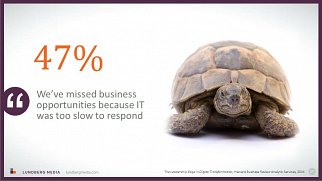Blog Post

Organizations often fall into new technologies haphazardly. Different groups discover new ways of working that better meet their needs, and they go for it. Eventually, CIOs find themselves with something of a jumble to manage.
Cloud is a particularly extreme example of this, as cloud services can be quite easy to sign onto. There are certainly categories of cloud services that CIOs don't need to control -- things that are opportunistic, department-specific and that don't need to link into core systems or data. As long as the acquiring business people understand and abide by some basic guidelines (mainly having to do with security), let a thousand flowers bloom.
However, when an organization starts to look to cloud for its enterprise IT needs, that's a very different story.
Blog Post

I had the pleasure of interviewing Apple co-founder Steve Wozniak onstage at the recent FISConnect conference. He told the audience of 1300 financial services leaders that every company today needs a chief disruption officer -- someone with a personal passion for a new way of doing things -- and that person should not report to the CEO.
Blog Post

Software-defined everything is a hot topic these days -- first and foremost because the pace of change in business is accelerating, and this is changing expectations for how IT operates. I've been hosting a lot of CIO roundtables and dinners on this topic, and I hear a growing consensus that if IT organizations don't figure out how to compete with nimble cloud providers to provide IT services on-demand, they will be outsourced. "IT has to virtualize and automate or die," one IT leader said.
While many CIOs see a "service broker" role in their future, a VP of IT from a global technology manufacturer actually predicts the dissolution of IT altogether. He believes that all of the functions that are part of IT today will be pushed out into engineering, or product development, and all that will remain in IT is governance. A year ago, that statement would have been immediately shot down. Not today ...
Blog Post

For the past two years, I’ve conducted a half dozen or so major research projects on digital business. At the outset, I looked for a definition that we could present to participating executives that would ground the research in something tangible. There wasn’t much out there. Even MIT's Center for Digital Business hadn't pinned this down. So we created our own definition as “the transformation of business models, products and/or operations from the use of information and communications technologies.”
OK, but wow, that was vague — transformation from what — and to what? Do a search today, and you'll find a lot more of the same.
Having completed all this research — survey results from thousands of business leaders around the world and interviews with close to a hundred executives, analysts and academics, my thinking has shifted. Today I define digital business as…
Blog Post

We all know how hard change can be. Whether we like to admit it or not, every one of us performs at least some parts of our jobs on auto-pilot; it's more efficient for our brains to operate that way. That makes it hard to do things differently.
When leaders introduce a significant change without a lot of communication around what will be different, why it's happening (including connecting it to something that matters to each member of the team), and how the change will unfold, they shoot themselves in the foot. They inevitably encounter a lot of friction if not downright resistance to the change. In the best case, this slows things down. In the worst, this has led to multi-million dollar failures.



